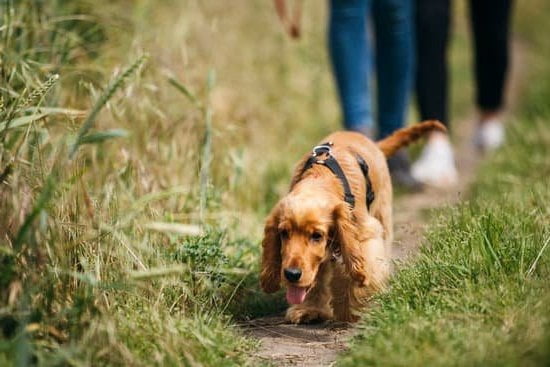Are you wondering, “how do I kennel train my dog?” Kennel training is an essential part of ensuring your dog’s safety and well-being, as well as providing them with a comfortable space of their own. In this article, we will explore the purpose of kennel training for your dog, the steps to take in introducing them to the kennel, and tips for establishing a positive routine.
When it comes to understanding the purpose of kennel training for your dog, it’s important to recognize that a kennel can provide a sense of security and ownership for your pet. It serves as a safe space where they can retreat when they need some alone time or when they feel anxious. Kennel training also helps in preventing destructive behaviors and provides them with a designated area for rest and relaxation.
Choosing the right kennel for your dog’s size and breed is crucial in ensuring their comfort and safety. Introducing your dog to the kennel in a positive way is key to their acceptance of it as their personal space. Establishing a routine for kennel training, using positive reinforcement, and dealing with common challenges are all essential steps in successfully kennel training your dog.
Choosing the Right Kennel for Your Dog’s Size and Breed
Consider Your Dog’s Size and Breed
When it comes to choosing the right kennel for your dog, size and breed are important factors to consider. You want to make sure that the kennel is large enough for your dog to stand up, turn around, and lie down comfortably.
For larger breeds, a crate with a divider can be helpful in creating a more appropriate space for training. Additionally, consider the strength of the material based on your dog’s breed – some dogs may require heavier-duty materials.
Types of Kennels
There are various types of kennels available, including wire crates, plastic crates, and soft-sided crates. Each type has its own benefits and drawbacks. Wire crates provide better ventilation and visibility for your dog but may not be suitable for every dog due to their design. Plastic crates offer more security and privacy but can feel confining for some dogs. Soft-sided crates are lightweight and portable, making them ideal for travel or temporary use.
The Importance of Proper Sizing
Whether you choose a wire crate, plastic crate, or soft-sided crate, ensuring proper sizing is crucial for successful kennel training. A crate that is too large may allow your dog to eliminate in one corner and sleep in another, defeating the purpose of using the crate as a potty training tool.
On the other hand, a crate that is too small can make your dog feel cramped and uncomfortable. Take accurate measurements of your dog before purchasing a kennel to ensure the right fit.
As you go through this process of choosing the right kennel for your dog’s size and breed remember to always keep an eye on your pup’s comfort levels with his new home way from home.
Introducing Your Dog to the Kennel in a Positive Way
When it comes to kennel training your dog, one of the most crucial steps is introducing them to the kennel in a positive way. This is important because you want your dog to view the kennel as a safe and secure space rather than a place of punishment.
To do this, start by placing some treats or their favorite toys inside the kennel to encourage them to go in on their own. You can also feed them their meals near the kennel so that they start associating it with something positive.
Another important aspect of introducing your dog to the kennel is making sure that they feel comfortable and at ease inside. You can achieve this by adding soft bedding, such as a blanket or a dog bed, to make the kennel cozy and inviting for them. Moreover, it’s essential to leave the door open initially so that your dog doesn’t feel trapped or confined while getting used to their new space.
It’s also crucial to avoid forcing your dog into the kennel or using it as a form of punishment. This can create negative associations with the kennel and make it more challenging for them to embrace it as their safe haven. Instead, focus on positive reinforcement and patience when introducing your dog to the kennel, ensuring that they feel comfortable and relaxed whenever they are inside.
| Aspect | Description |
|---|---|
| Positive Association | Encourage dogs with treats and toys |
| Comfort Inside | Add soft bedding for coziness |
| Avoid Force | Avoid forcing or using it as punishment |
Establishing a Routine for Kennel Training
Establishing a routine is crucial when it comes to kennel training your dog. Dogs thrive on routine and consistency, so it’s important to set a schedule for your dog’s meals, potty breaks, exercise, and time in the kennel. This will help your dog understand what is expected of them and make the training process more effective.
Start by setting specific times for when your dog will be put in the kennel and when they will be let out. Make sure to stick to these times as closely as possible to create a sense of predictability for your dog. It’s also important to ensure that your dog has had enough exercise and mental stimulation before being placed in the kennel to help them relax while inside.
Additionally, it’s essential to establish a bedtime routine so that your dog learns when it’s time to settle down for the night. Creating a calming pre-bedtime ritual can include activities such as going for a walk, having some quiet playtime, and then settling down in the kennel with a comforting blanket or toy.
Overall, establishing a routine for kennel training is essential for helping your dog feel secure and comfortable in their new environment. Consistency is key when it comes to shaping your dog’s behavior and ensuring successful kennel training.
| Importance of Routine | Benefits of Routine |
|---|---|
| Creates predictability | Helps dogs feel secure |
| Fosters good behavior | Makes training more effective |
Using Positive Reinforcement and Rewards for Successful Kennel Behavior
When it comes to kennel training your dog, using positive reinforcement and rewards is essential for successful behavior. By rewarding your dog for good behavior in the kennel, you are reinforcing the idea that the kennel is a safe and positive space. Here are some tips for using positive reinforcement effectively in kennel training:
- Use treats: When introducing your dog to the kennel, use treats to lure them inside and reward them for going in. Over time, you can gradually reduce the frequency of treats as your dog becomes more comfortable with the kennel.
- Verbal praise: In addition to treats, be sure to use verbal praise when your dog enters the kennel or exhibits calm behavior while inside. Dogs respond well to positive attention from their owners, so be sure to offer plenty of praise when they are doing well in the kennel.
- Interactive toys: Another way to reinforce positive behavior in the kennel is by providing interactive toys or chew toys that your dog enjoys. This can help keep them occupied and distracted while inside the kennel, and can serve as a reward for good behavior.
It’s important to remember that consistency is key when using positive reinforcement in kennel training. Be sure to reward your dog every time they exhibit good behavior in the kennel, and avoid using any form of punishment or negative reinforcement as this can create fear or anxiety around the kennel.
Overall, utilizing positive reinforcement and rewards is a great way to encourage successful kenneling behavior in your dog. By creating a positive association with the kennel through treats, verbal praise, and interactive toys, you can help make it a comfortable and enjoyable space for your furry friend.
Dealing With Common Challenges and Setbacks in Kennel Training
Kennel training your dog can be a rewarding experience, but it can also come with its own set of challenges and setbacks. It’s important to be patient and understanding as you work through these issues with your furry friend. Here are some common challenges you may encounter during kennel training and how to address them:
1. Whining or barking: Some dogs may whine or bark when they are first introduced to the kennel, especially if they are anxious about being confined. To address this behavior, start by making the kennel a positive and inviting space for your dog. Place their favorite toys or treats inside and encourage them to go in on their own. Once inside, offer praise and rewards to reinforce positive associations with the kennel.
2. Accidents in the kennel: If your dog has accidents in the kennel, it’s important not to scold or punish them. Instead, focus on establishing a regular potty schedule for your dog and take them outside frequently to eliminate any accidents. Clean any messes thoroughly to remove any scent that may attract your dog back to that spot.
3. Refusal to enter the kennel: Some dogs may initially refuse to go into the kennel, making it difficult to establish a routine for kennel training. In this case, you can use treats or toys to lure your dog into the kennel, creating a positive association with going inside.
Overall, it’s important to approach these challenges with patience and consistency. With time and effort, most dogs can learn to be comfortable and well-behaved in their kennels. Remember that every dog is different, so what works for one may not work for another-be open-minded and willing to adjust your approach as needed.
Gradually Increasing the Time Your Dog Spends in the Kennel
Start Small
When you first begin kennel training your dog, it’s important to start small and gradually increase the amount of time they spend in the kennel. Begin by leaving them in the kennel for short periods, such as 10-15 minutes at a time. Use this time to gauge their comfort level and behavior while in the kennel.
Monitor Your Dog’s Behavior
As you gradually increase the amount of time your dog spends in the kennel, it’s crucial to monitor their behavior closely. Look for signs of distress or anxiety, such as excessive panting, whining, or pacing. If you notice these behaviors, it may be a sign that you need to slow down the process and give your dog more time to adjust to being in the kennel.
Provide Comfort and Distractions
To help your dog feel more comfortable spending longer periods of time in the kennel, provide them with comfort items such as a favorite toy or blanket. You can also offer them interactive toys or puzzle feeders to keep them entertained while they are in the kennel. This can help create a positive association with being in the kennel and make it a more enjoyable experience for your dog.
By gradually increasing the time your dog spends in the kennel and monitoring their behavior closely, you can help them become more comfortable with this training method. Remember that every dog is different, so be patient and adjust your approach based on your individual pet’s needs. With consistency and positive reinforcement, you can successfully kennel train your dog.
Tips for Ensuring a Comfortable and Safe Environment in the Kennel for Your Dog
In conclusion, kennel training your dog can be a beneficial and positive experience for both you and your furry friend. By understanding the purpose of kennel training and choosing the right kennel for your dog’s size and breed, you can create a safe and comfortable environment for them. It is important to introduce the kennel to your dog in a positive way and establish a routine for training, using positive reinforcement and rewards for successful behavior.
When dealing with common challenges and setbacks in kennel training, it’s crucial to be patient and persistent. Gradually increasing the time your dog spends in the kennel will help them adjust and feel more comfortable in their new space. Additionally, implementing tips for ensuring a comfortable and safe environment in the kennel, such as providing bedding, toys, and proper ventilation, will make the experience more enjoyable for your dog.
If you find yourself asking “how do I kennel train my dog,” remember that consistency, patience, and positive reinforcement are key. With time and effort, you can successfully train your dog to view their kennel as a safe haven. Ultimately, creating a positive association with their kennel will lead to a happier and more well-adjusted pup.
Frequently Asked Questions
How Do You Train a Dog to Be in a Kennel?
Training a dog to be in a kennel involves positive reinforcement, patience, and consistency. Start by making the kennel a positive space with treats and toys, then gradually increase the time the dog spends inside.
How Long Does It Take for a Dog to Be Kennel Trained?
The time it takes for a dog to be kennel trained can vary depending on the dog’s age, temperament, and previous experiences with crates. Some dogs may become comfortable within a few days, while others may take weeks or even months.
How Do I Get My Puppy to Stop Crying in His Crate?
To get your puppy to stop crying in his crate, it’s important to address any underlying issues such as separation anxiety or fear of confinement. Gradually acclimate your puppy to the crate by creating positive associations with treats and comfort items inside.

Welcome to the blog! I am a professional dog trainer and have been working with dogs for many years. In this blog, I will be discussing various topics related to dog training, including tips, tricks, and advice. I hope you find this information helpful and informative. Thanks for reading!





